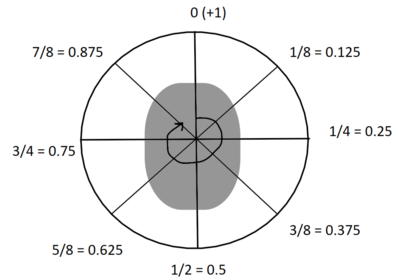RPM counting convention spring 23
From mn.fysikk.laglivlab
- Lasse, 16.08.23
Convention for counting cell RPM (Repetitions/Rotations per Minute) in LLL electrorotation experiments manually that has been used by the group up to this date. We have started developing an algorithm that would count rotational velocity automatically, but we use this method until we get it working.
- Every rotation experiment should be dated and documented on our wiki page, and should contain a table like the empty one below (example: 05.05.23). The table below can be copy-pasted into the editor of the page you're working on, columns can be added if the experiment covered more frequencies than these. The unit is rotation per 10 seconds because the recordings have a 10 second duration, these data are later converted to RPM in our data analysis python script.
Results (rotations per 10sec):
Each row for a clip is a different cell.
| 10kHz | 100kHz | 200kHz | 300kHz | 400kHz | 500kHz | 1MHz | 5MHz | 10MHz | 15MHz | 20MHz | 30MHz | 40MHz | 50MHz |
|---|---|---|---|---|---|---|---|---|---|---|---|---|---|
- On the harddisk in the FV420 lab we have dated folders for the experiments containing the recordings as sequences of images, separated by frequencies. These can be opened in for example ImageJ.
- In the recordings we are ideally interested in cells that are stationary at one point in the field, with a seemingly constant rotational frequency and with some distance to their neighbour cells. In many cases these conditions are not met (constant rotational frequency is necessary though because that's what we're measuring), so we just look for the cells that satisfy these points the best. Cells that don't satisfy these points at all should be ignored, and we have also previously ignored 'statistical outliers'; cells that for example have a drastically higher rotational frequency than all the others in a clip have been discarded in the past because we assumed that these cells were disturbed by neighbour cells and/or being close to the electrodes.
- Another potential error source is variance in the electric field; a cell in the middle of the rotation chamber and a cell closer to the electrodes experience the field differently. To compensate for this statistically, try to include cells at different positions.
- When counting the rotations of a cell during a 10 second clip, identify how the cell is orientated at the first frame. The cells as we record them are rarely perfectly spherical so you can use the ends of elongated cells, or imperfections along the membrane, to keep track of where the cell is 'pointing' at frame one (use a ruler or a finger or something to compare with when watching the motion). In the hypothetical case in the figure below, we decide that the cell is pointing up initially, and can think of it as the hour-hand of a clock and we can then identify where it points at the last frame to get our value. If the cell makes it a whole round or several before stopping, just add +1 or +2 or +3 etc.
- Also seen in the figure is that we mostly use quarter values (and eights), visualized as a clock that the 'hour-hand' moves along. The values have also been converted to decimals. This system limits the resolution of our RPM data and the greatest point of potential improvement from an automated solution that could measure the frequency more exactly, but it is sufficient for now.
- For counter-clockwise rotation, count the same way but remember to put in negative values instead. This is essential for us to find the turning point during data analysis.
